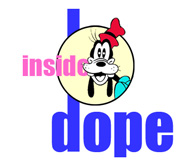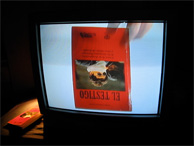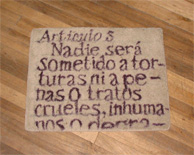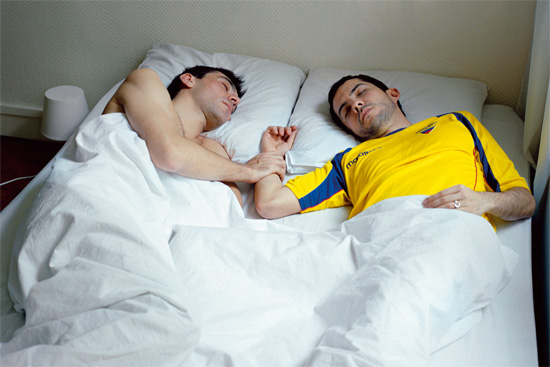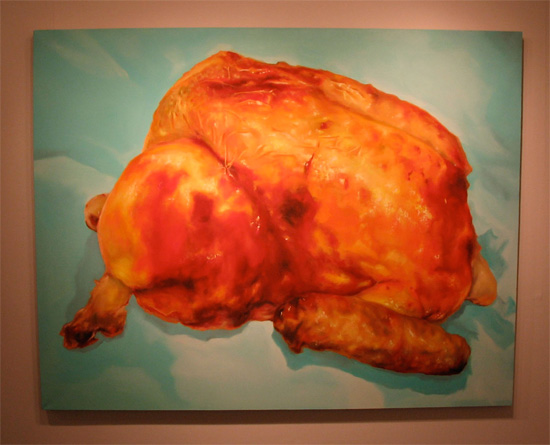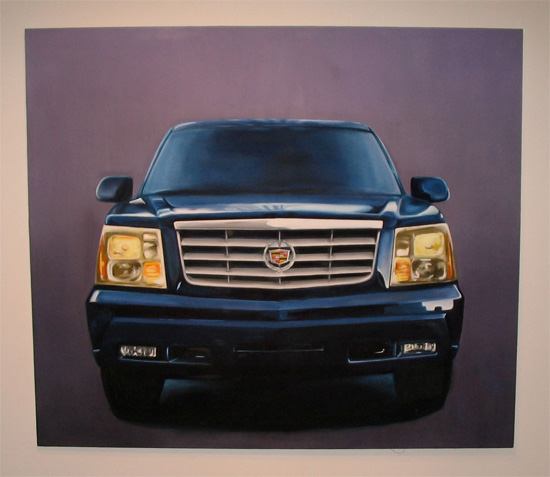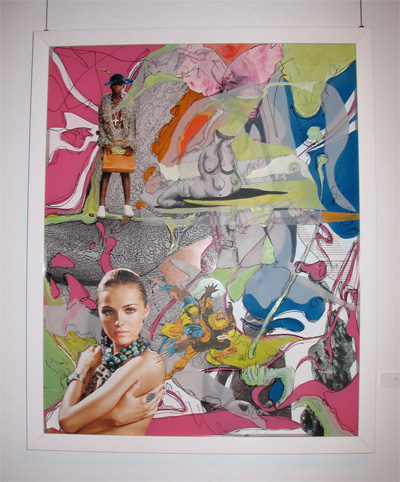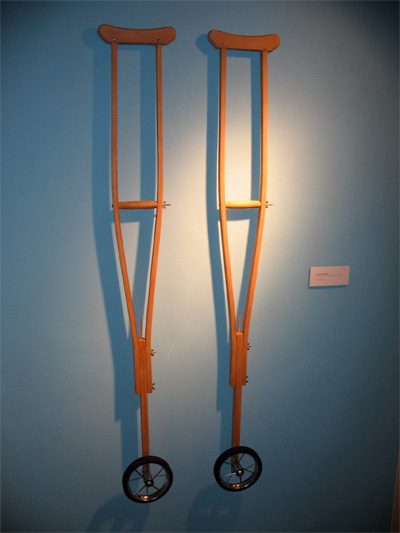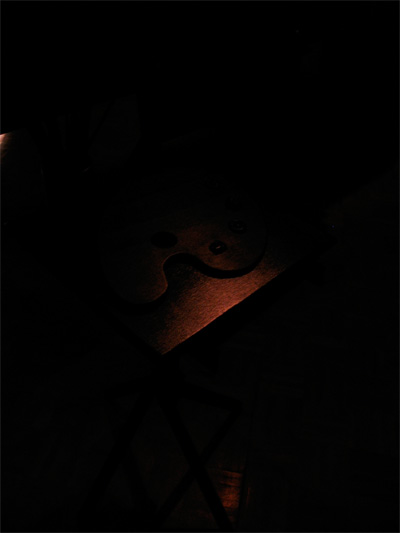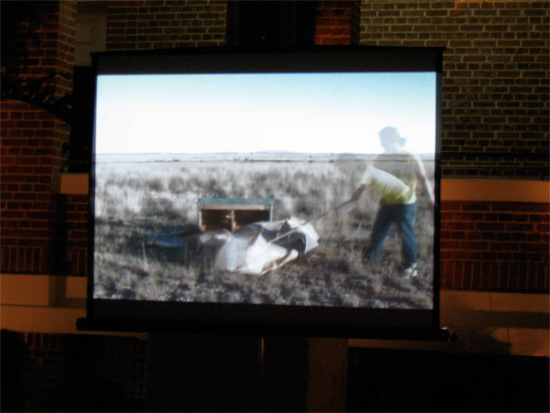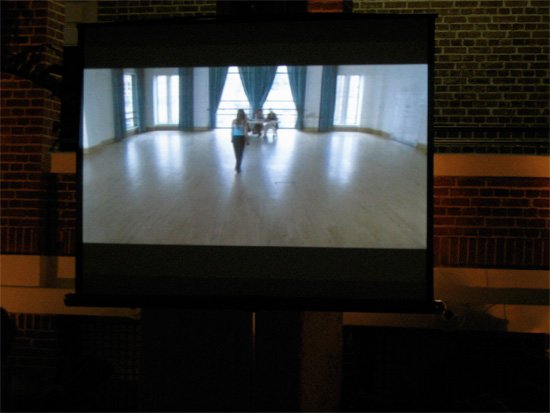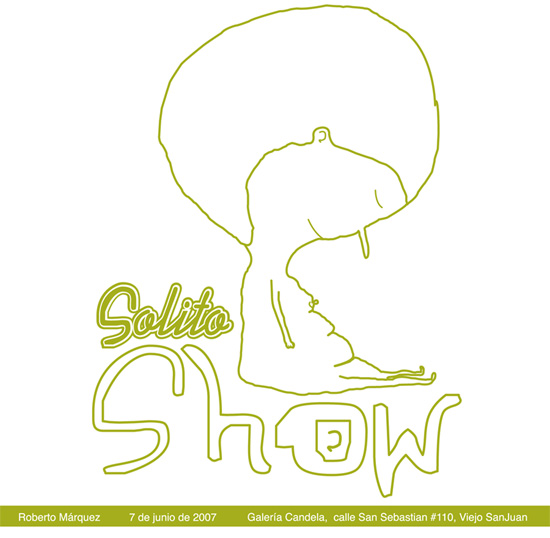|
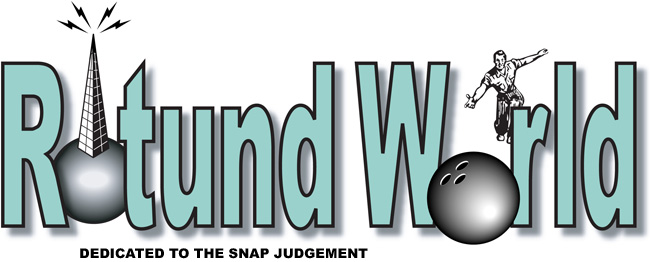
The Trouble with Some Folks
The image above, Ancestros/Ancestors, a hand-painted black-and-white photograph on canvas by Victor Vázquez (48" x 48", 1989), is apparently what got Vázquez in trouble with Cuenca, Ecuador, city officials during the 1997 Bienal Internacional de Cuenca; which, until that year, had been exclusively a showcase for painting, according to what the artist told us. It was not an auspicious beginning for the biennial’s first venture into “new media.” Even though the controversy began with visits by people unassociated with the art event— namely an archbishop and a government minion—Vázquez was not at all loath to blame biennial officials for the ensuing dust-up, which had him pinning the offending artwork to the wall with another of his images covering it. As we reported here, this all took place days before the biennial opened that year, and in an eerie repetition of the priggishness that seemed medieval even a decade ago, the city did it again in 2007.
As part of this year’s festivities, artist Santiago Reyes, with the help of curator María Fernanda Cartagena, had planned to display his banner Sin Título (Eric et moi dormant), featuring two chicos abed in a pose so decent it looks downright brotherly. City officials, however, had a different idea. They announced that the work offended the norms of the town and couldn’t be shown in public. The official language might seem hilariously cracked and decades out of it, but we found it infuriatingly obtuse. According to the Cuenca daily Hoy, the city’s director of urban control Pablo Barzallo called the work “sexist,” and culture czarina Margarita Vega defended its censure because otherwise “the little children would think this is a normal scene.” Without too much mental exertion, it is possible to count the ways in which every upraised snoot in Cuenca—perhaps in all of Ecuador—might find itself out of joint over what Vázquez asked them to look upon back in ‘97. The cross is a dead give-away in this stoutly Catholic redoubt, painted as it is on what looks like a Muslim-style veil and in close proximity to abundantly exposed female flesh and a heap of fruit, twigs, and possible filth. That’s quite the taboo cocktail Vázquez has shaken, and it’s no wonder the image gave pause to the mild folk of the sierra. Neither is it a stretch to say that the Cuenca International Biennial has not exactly solidified its reputation as one of the foremost Latin American art biennials when it allows itself to be bullied by the town’s thin-lipped civic elite. On the contrary. Given the relative graphicness of the two images, you could easily argue that the biennial is in a state of decline. To be fair, biennial officials immediately issued a press release condemning the city’s action and scheduled a symposium with Reyes and Cartagena soon after the opening ceremonies. The banner was reportedly strung up, finally, in one of the several biennial venues, a small museum with a courtyard easily closed off from the street where it could be viewed by delicate-minded niñitos. Above all, we don’t want to minimize the difficulties of pulling off an enterprise as complicated as the Cuenca Biennial, nor can we deny that we had a swell time while we were there. But given the event’s history with censorship, an organization with any sense of responsibility toward the artists it invites, not to mention the public it supposedly serves, should have seen the yahoos coming a mile away. Thanks to the artist and Walter Otero Gallery in San Juan, Puerto Rico, for the image of Ancestros/Ancestors, and to the IX Bienal Internacional de Cuenca for the image below it, showing Santiago Reyes’s artwork. Back in the Land of the Putatively SanePerhaps Puerto Rico was quiet as a mouse in our absence, art-wise, but we doubt it. On our return we tried to catch up a bit, visiting some galleries and hitting an event or two. Gamaliel Rodríguez-Ayala opened an exhibition of superrealist-style paintings at La Casa del Arte, and were we surprized? You bet. We know Rodríguez-Ayala mostly as a maker of prickly—sometimes barbed—installations, like his razorwire-rubble-and-prayer-rug “There Is Always Hope” at La Muestra Nacional. For Guillermo Rodríguez’s space, he showed up with pictures of trucks, jets, guns, bacteria, and chickens that left us dumbfounded. These are richly executed, colorful, and certainly premonitory images for the beseiged citizen, and the paintings are invested with a kind of sure-handedness we have come to appreciate in nearly everything the artist touches. Still, we like the plucked chicken for its glistening, canny sickliness—its gross animality, in other words—far more than for the topic on which the painting’s based, bird flu. That’s the problem with topicality. It’s only topical for a moment, and it never trumps what the stomach sees, or the chest, or the place between your legs.
Top above: Chicken Flu, oil on linen, 55" x 70", 2006. Below: Escalade, oil on linen, 62" x 72", 2006. These are perfectly rectangular canvases, folks; please forgive the distortion in the images due to our cheapjack equipment, not to mention our technique. Rodríguez- Ayala’s exhibition, Copy/Paste, is on view now at La Casa del Arte, Avenida Andalucía #500. Visit The Storehouse Group website for further information, or phone 787-792-7373 and you might be fortunate enough to talk to the artist himself. The other visits on our whirlwind tour of the San Juan art scene included a stop at Carmen Correa Contemporary—Correa’s title for the active-artist side of her roster, which also features historical names with considerable heft—to see new work by Iván Girona. The show’s title, Intenso, pretty much captures the tone of this extensive display of new work, mostly collages, painting, and drawing on plexiglass. We believe that what Girona’s been up to since he joined forces with Correa is much stronger than what we saw before—which, we admit, is pretty much limited to what he showed at last year’s El Polverío—and ordinarily we have no trouble with a mix of porn and fashion imagery and comics creatures in battle, especially when its leavened with a bit of humor. But this show left us wondering about the artist’s sense of proportion: almost everywhere that there’s an image of a woman, it’s hardcore and ugly. We confess to being uncertain about what we were seeing: attempts at incisive commentary or unfortunate glimpses into the artist’s underdevelopment? No doubt time will tell, and all the red dots on Correa’s walls indicate that collectors, at any rate, have already given a thumbs-up to the health of the Girona’s outlook.
The work above, titled . . . A Super Model When I Grow Up (mixed media on acrylic, 36" x 24", 2006), appealed to us for, well, we really don’t know why, exactly. Maybe it’s the drawing and maybe it’s the convincing amount of pink, which, we’re always joking, is what an artist’s work needs when the artist asks us for advice. Correa’s gallery is located at Calle San Jorge 707, and she tends to keep regular hours. But if you’re going to visit—and we encourage you to see Girona’s show for yourself—you might want to ring the gallery up: 787-268-2518. As most Rotund readers know, Galería 356 at César González 356 in Hato Rey has become one of our regular stops. This month director Michele Fiedler has given the gallery entirely over to the Duchampian shenanigans of Miguel Ángel Torres Aponte: a desk with a chair too tall to sit in, a triptych of paintings turned to the wall, rocks plugged into electric sockets. Each item is worked to a faretheewell, and that’s what we like about the show since craft is often trumped by concept among the island’s contemporary artists. Nothing wrong with that, but personally we admire the well-made object. On the other hand, overall these particular objects seem a little too thoroughly worked over for our tastes, especially dealing as they do with art at the rough edges of thought. Just as we tend to like craft, we also get into mess, and the ideal for us—except when it comes to clay pots—is a mezcla sabrosa. Still, there were a couple of works that struck us just right. One of them, El disfraz de la dichosa globalización (top below, crutches and wheels, dimensions variable, 1999), is an immediately gettable pleasure, no matter what way you take it. The darkened room of black paintings, black furniture, and black artist’s tools, Naturaleza Muerta (next image down, detail, wood, canvas, and paintbrushes, dimensions variable, 2006-07), is another bon mot that works on several levels, from the simple pun of the name to the mordant commentary on the state of contemporary art.
This is an exhibition where any thinking person will probably find something to like, and perhaps the more cerebral you are the more you’ll appreciate the show. Galería 356 is another space that tends to be open when you want it to be; that is, whenever you’re in the neighborhood, but as with anything, it pays to call before you set out: 787-282-7820. You can also contact Michele by email or visit the gallery’s glimmering website. San Juan after dark continues to burble with events, discussions, symposia, and other arty moments, such as occurred at el Museo de Arte Contemporáneo a few nights back when Galería 356 presented a video program Fiedler helped organize with video artist Myritza Castillo-Irizarry, who was the program’s curator. Castillo Irizarry put together an impressive list, including Daniel Silvo—with whom she has worked—Maribel Castro, Alberto Chinchón, Quintín Rivera Toro, Oscar Castellanos, Carmen Álvarez, and Joel Pérez Irizarry. After the video program, Rivera Toro and Pérez Irizarry talked about their beginnings and the evolution of their work with video. Our top fave was the snot and drool fest which Chinchón produced, literally, while facing some sort of wind generator and wearing a dental appliance which forced his mouth into a hideous smile-grimace. The suffering of the artist, no doubt. But really, it was fascinating to see how long he could take it, and with what forebearance. A perfect metaphor not just for the artist but for the observer as well. We also liked Rivera Toro’s forceful whapping of big objects in a desert landscape reminiscent of the one where Donald Judd much more peaceably constructed big concrete boxes, and our soundtrack of the night award went to Silva’s plate of dancing olives, Technoaceitunas. You could think of numerous local names left out of the running, but it was a tight program sketching the robust health of video art here and abroad.
Scenes from, top above, Rivera Toro’s almost three minute Trabajar, jugar, amar, from 2004, and Pérez Irizarry’s ten minute, narratively complex Sheepdog, from 2005. What the Crystal Ball SaysWe’re gazing into the future for once, and it looks hotter than a two dollar pistol. Those mischievous and very avant gardists at Casa Candela are cooking up a summer’s worth of exhibitions at Pablo Rodríguez’s space upstairs from the bar—how boho!—and they’ve put more than a pinch of spice into their plans. Beginning in early June, Abdiel Segarra and company have arranged to show paintings, drawings, and installations by none other than Roberto Márquez.
Later in the month, we’ve got blog. Opening June 21, a self-titled show whose portent should be obvious to any sentient twenty-first century creature, namely:
The geezers at Rotund World are not one hundred percent certain what a blog is, but we think it’s something you smoke, like a spliff, right? We’d call the authorities, but we don’t want to miss out on the goodies. You shouldn’t either. Watch this space for further Candela doings. Will we do more wrapping up? Does the Pope shit in the woods? As long as Puerto Rico continues to pop like a June bug in hot cooking oil, we’ll do the do. Meantime, you can relive the IX Bienal Internacional de Cuenca, and its prelude, all over again. Are you really not tired of Cuenca? Head on down, here. |
